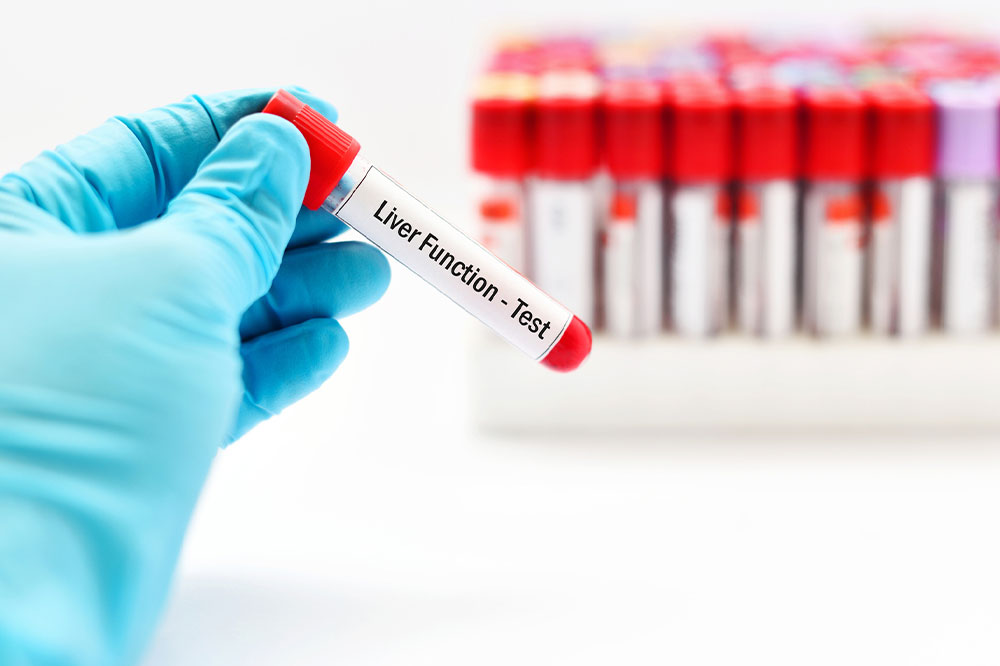
Liver function tests – Purpose, types, and procedure
A liver function test, commonly known as an LFT or liver chemistry, helps understand the health of the liver. It does so by measuring various proteins and enzymes present in the bloodstream. If the levels of these proteins and liver enzymes are elevated or lower than normal, it could indicate that the liver is not functioning properly. Read on to learn more about why doctors recommend LFTs, what parameters are tested, and more.
When do doctors prescribe a liver function test?
A liver function test is prescribed to check if the liver is functioning effectively and efficiently. It is recommended for various reasons. One of the major reasons to prescribe a liver function test is to check for liver infections such as hepatitis A or hepatitis B. It can also be recommended if doctors suspect that liver damage is occurring as a side effect of certain treatments. Doctors may also suggest a liver function test if the individual is already having liver disease or other conditions such as high blood pressure or diabetes. These tests are great for keeping track of liver health and monitoring prescribed treatments’ effectiveness. In rare cases, doctors may also prescribe getting liver function tests if there is a family history of liver disorders or liver disease.
Different parameters of liver function tests
The liver function test is used to check different parameters such as specific enzymes and proteins in the blood. Some of these common parameters are mentioned below:
- Alanine transaminase (ALT) test
Alanine transaminase (ALT) test is used to measure the ALT levels in the body. Alanine transaminase is used by the body to process and metabolize proteins. But if the liver is not functioning effectively, ALT can be released into the bloodstream. This causes an increase in the ALT levels. - Alkaline phosphatase (ALP) test
Alkaline phosphatase, commonly referred to as ALP, is an enzyme present in the bones and liver. Elevated levels can indicate damage to liver function. They can also indicate liver inflammation, blockage in the bile ducts, or bone conditions and diseases. ALP tests are usually performed along with other tests. - Albumin test
Albumin is a protein that is created by the liver. It has many essential functions, including transporting hormones, vitamins, and other substances throughout the body. A liver function test that checks for albumin measures how well the liver is creating this enzyme. - Bilirubin test
Bilirubin is waste that is generated by the breakdown of red blood cells in the body. It is processed by the liver and excreted from the body via the stool. If there is some damage to the liver or the liver is not functioning efficiently, there will be elevated levels of bilirubin in the blood. In rare cases, individuals may also have elevated bilirubin levels due to genetic or inherited diseases. - Aspartate aminotransferase (AST) test
Aspartate aminotransferase, also known as AST, is an enzyme found in various parts of the body. If the liver is not functioning properly, AST can be released into the bloodstream. AST is usually tested along with ALT. This is because AST by itself cannot be used as a marker for liver damage. On the other hand, a very high AST level on the test can indicate a problem with the liver or muscles.
How to prepare for a liver function test?
Typically, the doctor in charge of conducting the tests will provide patients with complete instructions to prepare for the test. If one is taking certain treatments to tackle liver diseases and disorders or other health conditions, doctors may ask one to avoid them. This is because these treatments can affect the levels of enzymes and proteins in the blood and manipulate the results. Doctors may also ask one to fast for 10 to 12 hours before the test.
Potential risks of a liver function test
Doctors need to draw blood in a hospital or specialized testing facility to perform a liver function test. Blood draws are a very safe procedure and rarely have any side effects. But in very rare cases, individuals may have certain risks. These include bleeding under the skin, excessive bleeding, fainting, or in worse cases, infection. Note that these risks are very rare. Doctors suggest that the patients wait in the testing facility for a while so they can monitor the individual. They also do this to ensure that patients do not feel light-headed or faint after giving blood.




